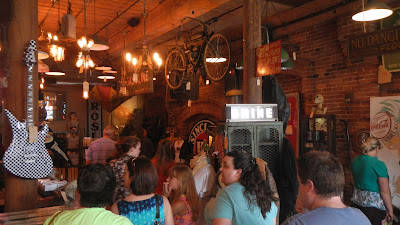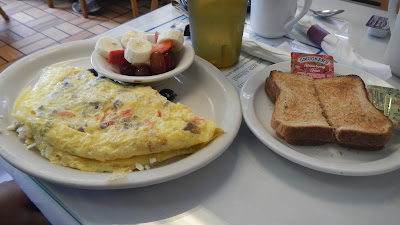For those of you who are unfamiliar with
the TV series, it follows Mike Wolfe and Frank Fritz as they travel around the
United States, (mostly in the Midwest and South), buying or "picking"
antiques and collectibles. Danielle
Colby-Cushman runs the office and home store for ‘Antique Archeology’, Mike’s
business based in Le Claire, Iowa. Frank
sells what he acquires through his own website.
In December 2011, American Pickers
revealed that Antique Archaeology had leased space for a second store in a former
1910s car factory in Nashville, Tennessee.
The Marathon Automobile plant is listed in the National Register of
Historic Places.
It was our last day to explore
Nashville’s attractions…and with both Laurie and Dawn being fans of the TV
show, Mike’s store was on our list for a visit.
It was Sunday…and despite the store being
located in an old auto plant a bit off the beaten track, the store was
busy! Lots of tourists were coming and
going, looking and buying…and just plain gawking during our visit. (Laurie and
I remember the show when the boys bought the pig’s head…and Frank tried it on!)
Mike and Frank explore people's homes,
barns, sheds and outbuildings…anywhere where they’ve stored or hoarded junk, antiques
and collectibles. They search the country for potential picking goldmines. Much of what they buy during these forays
into the country side wouldn’t get a second glance from the casual
passerby. Mike has a particular interest
in antique motorcycles, air-cooled Volkswagens, old bicycles and
penny-farthings. Frank has a fondness
for antique toys, oil cans, and old Hondas.
They’ve purchased old advertisements and commercial signage, film
posters, motorcycle parts, bicycles, railroad lanterns, a rare 15-gallon
visible gasoline pump, and even some old cars that appear to be total
wrecks.
The shop in Nashville is interesting and
definitely eclectic! We noticed that
many of the items aren’t for sale…just part of the décor. Gloves, t-shirts and souvenirs make up a lot
of the business… It was $25.00 for a t-shirt at Antique Archaeology. We understood that we'd just missed a visit by Mike to his store.
This is one of the treasures on display
in the store… It’s one of the most famous characters in the history of American
advertising. It was the Fisk Tire Company's sleepy boy. He shouldered an oversize tire while dangling
a lighted candle. The ad came with the
slogan "Time to Re-tire". We
know that this image is pre-1929, because the yawn was turned into a smile in
that year and 2-piece pajamas were added in 1930. In its day, this character was so popular
that Norman Rockwell did a series of paintings based on the little boy who was
ready for bed, lugging a large Fisk tire on his arm.
The Fisk Tire Company was founded in 1898
by Noyes W. Fisk and his son Harry.
Originally a manufacturer of bicycle tires, the company soon became a
major producer of automobile tires. By
1916, Fisk was producing 5,000 tires per day.
In 1940, Fisk was acquired by U. S. Rubber, which changed its name to
Uniroyal in 1967 and then merged with B. F. Goodrich in 1986. Michelin bought the company in 1990 and
Fisk-branded tires are still sold today through the Discount Tire Company’s 850
+ stores in 25 states.
Laurie loves carrousel and hobby horses…
Forget the horse! Just the price of this
horse’s Roy Rogers Child Saddle gave me palpations! However you can pick it up for 'only' $650.00!
I don’t know what this wooden cutout was
for…obviously to promote some event many years ago. Maybe a shooting gallery target stand-up? When you aim at him & shoot, his eyes light up? One of many guesses...Laurie and I both remember the show when Mike
and Frank picked up this item… It is indeed a bit strange, albeit eye-catching.
There are Facebook and all kinds of
Internet connections for Mike, Frank and the Antique Archaeology stores. For information re: the stores, go to http://antiquearchaeology.com/index.html. This particular store is located at 1300
Clinton Street, Suite 130 (Marathon Village), in Nashville Tennessee.
FYI, Mike and Frank’s able assistant on
the show, Danielle Colby Cushman, a former roller derby skater and burlesque
show entrepreneur, has her own clothing boutique, ‘4 Miles 2 Memphis’, in the
Wicker Park neighborhood of Chicago. To
learn more about this TV Reality Show, you can go to http://www.history.com/shows/american-pickers.
One more photo inside the Antique
Archaeology Store… They have a little stage area set up just to the right of
the entrance to the store and there is a bit of live entertainment offered…probably
on weekends only…but I don’t know for sure.
In any case, this is “A Man Called Bruce”. Reflecting the musical heritage of his home
in Cleveland Tennessee, A Man Called Bruce’s music is rooted in rock, country,
and blues. Laurie did buy one of his CDs…
For more about “A Man Called Bruce”, (I couldn’t find his real or original name
anywhere), check him out at http://www.reverbnation.com/amancalledbruce
or https://www.facebook.com/AManCalledBruce.
Marathon Motor Works was an early
automobile manufacturer based in Tennessee. It grew out of an earlier company
called Southern Engine and Boiler Works founded in 1889, which made industrial
engines and boilers in Jackson, Tennessee. As such, the firm had metal-working
and power plant experience which could easily be transferred into the then-new
and rapidly expanding automobile industry. From 1907 to 1914, the company manufactured
the Marathon automobile. This particular
plant was opened in 1910…
This is a very rare Marathon
automobile. I borrowed this photo from
Wikipedia… Allegedly, although thousands of Marathon autos were built, only 8
or 9 examples are known to exist today. At
least two of them are can be found in the old Nashville plant facility…the same
building that houses Antique Archaeology.
For more information on this site and its comeback as a 'go to location'
in Nashville, just go to http://www.marathonvillage.com/zenphoto/album02/.
This coffee shop is in the old Marathon
plant facility just down the way from the Antique Archaeology store. Appropriately, it’s called the Garage Coffee
Company. We stopped here for a break and
a cup of coffee before taking Dawn Marie to the Nashville airport for her
flight home. Check out the Garage Coffee
Company at http://garagecoffeecompany.com/photo-gallery.
Well…here’s Dawn Marie raising her coffee
cup to our busy, fun and interesting 2-day exploration of the Nashville Tennessee
vicinity and some of its many attractions and restaurants. From here we were all off on our journey’s
home. Laurie and I only had about 2 ½ hours
of driving ahead of us…
(Note: There will be one more Nashville
related blog published that will complete our tour of the Lane Motor Museum)
Just click on any of the photos to
enlarge them…
Thanks for joining us on our weekend
adventure!
Take Care, Big Daddy Dave

















































